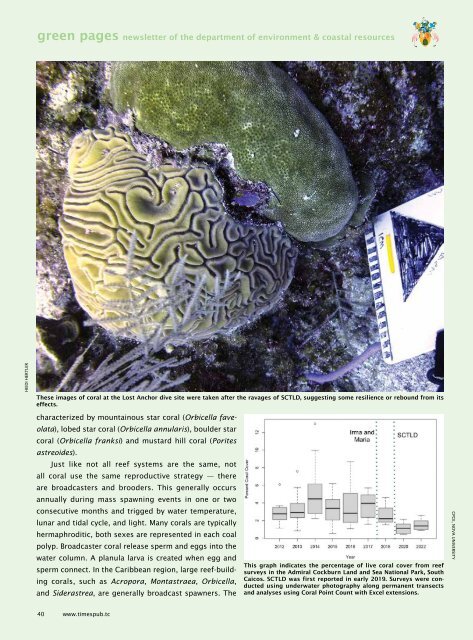Times of the Islands Fall 2022
Presents the "soul of the Turks & Caicos Islands" with in-depth features about local people, culture, history, environment, real estate, businesses, resorts, restaurants and activities.
Presents the "soul of the Turks & Caicos Islands" with in-depth features about local people, culture, history, environment, real estate, businesses, resorts, restaurants and activities.
Create successful ePaper yourself
Turn your PDF publications into a flip-book with our unique Google optimized e-Paper software.
green pages newsletter <strong>of</strong> <strong>the</strong> department <strong>of</strong> environment & coastal resources<br />
HEIDI HERTLER<br />
These images <strong>of</strong> coral at <strong>the</strong> Lost Anchor dive site were taken after <strong>the</strong> ravages <strong>of</strong> SCTLD, suggesting some resilience or rebound from its<br />
effects.<br />
characterized by mountainous star coral (Orbicella faveolata),<br />
lobed star coral (Orbicella annularis), boulder star<br />
coral (Orbicella franksi) and mustard hill coral (Porites<br />
astreoides).<br />
Just like not all reef systems are <strong>the</strong> same, not<br />
all coral use <strong>the</strong> same reproductive strategy — <strong>the</strong>re<br />
are broadcasters and brooders. This generally occurs<br />
annually during mass spawning events in one or two<br />
consecutive months and trigged by water temperature,<br />
lunar and tidal cycle, and light. Many corals are typically<br />
hermaphroditic, both sexes are represented in each coal<br />
polyp. Broadcaster coral release sperm and eggs into <strong>the</strong><br />
water column. A planula larva is created when egg and<br />
sperm connect. In <strong>the</strong> Caribbean region, large reef-building<br />
corals, such as Acropora, Montastraea, Orbicella,<br />
and Siderastrea, are generally broadcast spawners. The<br />
This graph indicates <strong>the</strong> percentage <strong>of</strong> live coral cover from reef<br />
surveys in <strong>the</strong> Admiral Cockburn Land and Sea National Park, South<br />
Caicos. SCTLD was first reported in early 2019. Surveys were conducted<br />
using underwater photography along permanent transects<br />
and analyses using Coral Point Count with Excel extensions.<br />
CPCE, NOVA UNIVERSITY<br />
40 www.timespub.tc
















